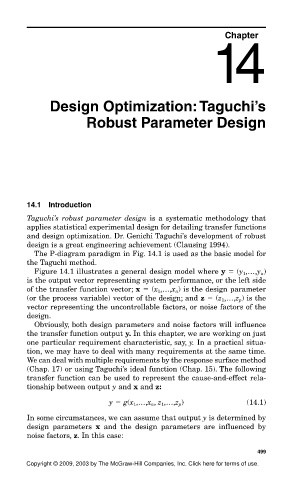Page 540 - Design for Six Sigma a Roadmap for Product Development
P. 540
Chapter
14
Design Optimization:Taguchi’s
Robust Parameter Design
14.1 Introduction
Taguchi’s robust parameter design is a systematic methodology that
applies statistical experimental design for detailing transfer functions
and design optimization. Dr. Genichi Taguchi’s development of robust
design is a great engineering achievement (Clausing 1994).
The P-diagram paradigm in Fig. 14.1 is used as the basic model for
the Taguchi method.
Figure 14.1 illustrates a general design model where y (y 1 ,…,y u )
is the output vector representing system performance, or the left side
of the transfer function vector; x (x 1 ,…,x n ) is the design parameter
(or the process variable) vector of the design; and z (z 1 ,…,z p ) is the
vector representing the uncontrollable factors, or noise factors of the
design.
Obviously, both design parameters and noise factors will influence
the transfer function output y. In this chapter, we are working on just
one particular requirement characteristic, say, y. In a practical situa-
tion, we may have to deal with many requirements at the same time.
We can deal with multiple requirements by the response surface method
(Chap. 17) or using Taguchi’s ideal function (Chap. 15). The following
transfer function can be used to represent the cause-and-effect rela-
tionship between output y and x and z:
y g(x 1 ,…,x n , z 1 ,…,z p ) (14.1)
In some circumstances, we can assume that output y is determined by
design parameters x and the design parameters are influenced by
noise factors, z. In this case:
499
Copyright © 2009, 2003 by The McGraw-Hill Companies, Inc. Click here for terms of use.

